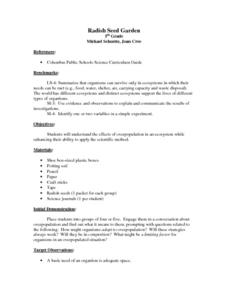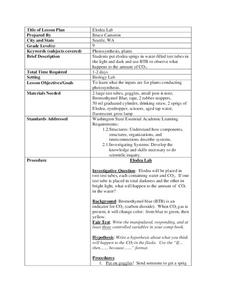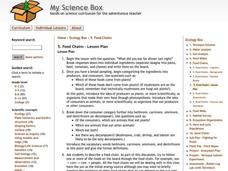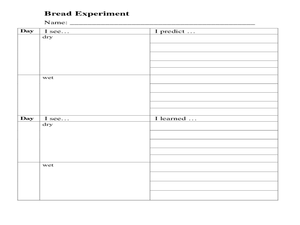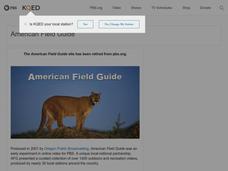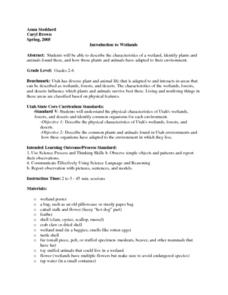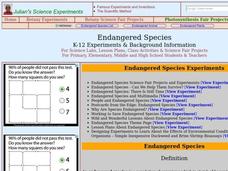Curated OER
Spring Fever
Students grow plants from seeds that can later be placed in outdoor settings. They care for the seeds while they germinate and begin to leaf out.
Curated OER
Radish Seed Garden
Fifth graders explore the effects of overpopulation in an ecosystem while applying the scientific method. They discuss overpopulation and its meaning. Students as an organism competes for space in an overpopulated area. They plant...
Curated OER
Relationships and Biodiversity Lab Practice
In this biodiversity worksheet, students determine the relationship and complete the evolutionary tree for the plants listed. Students review genetic code and DNA sequencing. This worksheet has 1 graphic organizer, 8 multiple choice, and...
Curated OER
Elodea Lab
Pupils observe the changes between elodea leaves placed in darkness and light. In this life science lesson, students experiment to find evidence of photosynthesis in elodea leaves. Pupils use indicators to detect the presences of...
Curated OER
Traits of Living Things
In this characteristics of living things worksheet, students will brainstorm five traits of living things and fill in a graphic organizer.
Curated OER
What Are the Needs of Living Things?
In this living things worksheet, students will write down two facts about what a living thing needs to survive. Using these facts, students will draw a conclusion to how those needs are met.
Curated OER
How Do Adaptations Help Living Things?
In this adaptations worksheet, students will brainstorm a problem that a living thing might face in its environment. Then students will write down what solution or adaptation that living thing has that allows it to survive that...
Curated OER
How Do Nitrogen and Water Cycle?
In this nitrogen and water cycle worksheet, students will brainstorm a main idea about the nitrogen cycle or the water cycle. Then the student will write in three details that support their main idea.
Curated OER
Build an Anchialine Pond
Students explore biology by conducting a nature experiment. In this pond examination lesson, students utilize recycled materials, play-doh and water to recreate a pond and its inhabitants. Students identify the different elements within...
Curated OER
Food Chains
Students describe food cahins and the role of organisms. Using a set of organism cards, they color code the organisms on their cards by their role in the food chain. Once a complete chain is identified, they glue it on a sheet of paper.
Curated OER
Flower Power
Students explore the parts of flowers and how they reproduce. They dissect flowers and observe the reproductive organs. Students observe anthers and ovaries of Tiger Lilies under a microscope. They investigate how insects and other...
Curated OER
Plant Structure and Growth
This plant structure and function PowerPoint addresses the main organs and the factors that affect its development as well as going into detail about the specializations at a cellular level. The cell functions and system...
Curated OER
Mini-Ponds
In this mini pond worksheet, students create a mini-pond ecosystem with soil, water, and plant life. Students let their ecosystem sit for a day and they observe a sample the next day. Students identify all the pond water microorganisms...
Curated OER
Photosynthesis: Using the Sun to Make Food
In this photosynthesis worksheet, students learn how plants use the sun to convert energy into food. They then answer 10 questions using the information they just read. The answers are on the last page.
Curated OER
Wild Arctic
Students explore key terms, including food web and food chain. They discuss Arctic plants and animals, devise at least three Arctic food chains and create a food web showing connections among Arctic life.
Curated OER
Photosynthesis Cookies
Students identify photosynthesis as a process through which organisms make their own food. They practice the process for writing the formula for the photosynthesis equation.
Students describe how the processes of photosynthesis and...
Curated OER
The Wetlands
Fourth graders learn what a wetland is, where they can be found, and what types of plants, animals and characteristic are associated with the wetlands. They also participate in an activity to explore and enhance their knowledge of...
Curated OER
Forest Decomposition
Young scholars explore decomposition. Students define and describe components of the decomposition process. Young scholars make a composter in a terrarium. Students record observations and changes weekly, drawing conclusions about...
Curated OER
The Formation and Value of Temperate Grasslands
Students get an overview of the climate and organisms of the North American Prairie. After a lecture, and watching some videos imbedded in this plan, students compile research data on the North American Prairie.
Curated OER
Introduction to Wetlands
Students describe the characteristics of a wetland, identify plants and animals found there, and how those plants and animals have adapted to their environment. They visit stations, view a video, and complete a KWL about the wetlands.
Curated OER
Endangered Species
Students create a postcard about endangered species. In this biology lesson, students identify how human activities endanger other species. They research and recommend ways to help protect them.
Curated OER
The Six Kingdoms
In this evolution activity, learners will determine the evolutionary relationships among organisms using cladograms and phylogenetic diagrams. This activity has 13 short answer questions and 3 multiple choice questions.
Curated OER
Panther Trivia Pursuit
Sixth graders design trivia game about panthers. In this panther trivia game lesson plan, 6th graders use the Internet to research interesting information about panthers, write the facts on note cards, and create a game based on...
Curated OER
Web of Life - Role-Playing
Students role-play how organisms adapt to their environment. They play 20 questions with plant and animal habitats. They create a web of life to demonstrate how each plant and animal relies on the other for survival.

